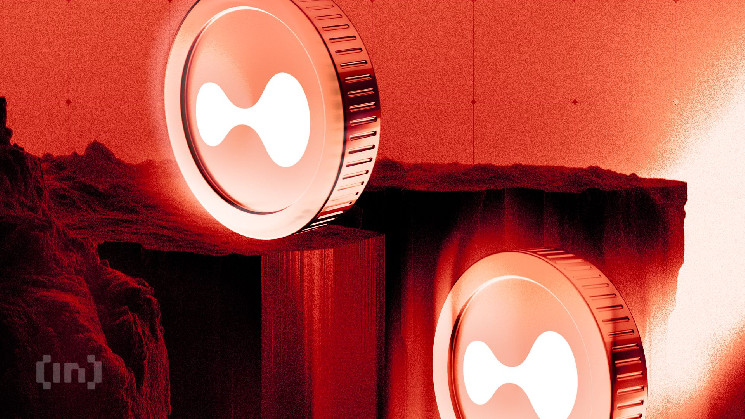Hyperliquid DEX Under Siege: Rumors of North Korean Hacking Spark Massive Outflows and HYPE Token Plunge
The decentralized exchange (DEX) Hyperliquid has found itself in a maelstrom of negative publicity and market turmoil, triggered by unconfirmed reports of North Korean hacking activity targeting the platform. These rumors, combined with significant USDC outflows and a precipitous drop in the value of its native token, HYPE, have painted a grim picture for the DEX’s immediate future. The situation underscores the inherent vulnerabilities of the decentralized finance (DeFi) space, highlighting the risks associated with security breaches and the often-swift market reactions to such uncertainties.
The catalyst for this crisis appears to be a post by cybersecurity expert Tayvano on the social media platform X (formerly Twitter), alleging on-chain evidence pointing to coordinated attacks by North Korean hackers on Hyperliquid. Tayvano’s claims suggest that these hackers have been actively trading on the platform, incurring losses exceeding $700,000 since their operations began. While Hyperliquid has yet to issue an official statement addressing these allegations, the mere speculation has sparked a wave of panic among users, leading to a mass exodus of funds from the platform.
The magnitude of this outflow is alarming. Data from Dune Analytics reveals that USDC outflows from Hyperliquid have reached a staggering $61 million in a single day, shattering previous records. This dramatic withdrawal of funds reflects the widespread fear and uncertainty gripping the Hyperliquid user base, as investors prioritize safeguarding their assets over the potential risks of remaining on a potentially compromised platform.
The repercussions of this mass exodus have been devastating for HYPE, Hyperliquid’s native token. The altcoin has witnessed a double-digit percentage drop in value, plummeting over 10% within a 24-hour period. This decline is directly correlated to the outflow of funds, as panicked selling creates an oversupply of HYPE tokens in the market, pushing its price downwards. This downward spiral is further exacerbated by the surge in HYPE’s trading volume, which has reached unprecedented levels, indicating a frenzied rush to sell. This negative divergence, where price falls while trading volume spikes, is a classic sign of intense selling pressure, further reinforcing the bearish sentiment surrounding the token.
Analyzing HYPE’s price action reveals a critical resistance level at $29.93. The token currently trades below this level, suggesting that the selling pressure is relentless. If this trend persists, HYPE’s price could further descend towards the support level at $26.12. A failure to hold this support could trigger a cascade effect, leading to a potential drop to $22.32. This bearish outlook underscores the gravity of the situation and the challenges HYPE faces in the near term.
While the overall sentiment remains decidedly bearish, a glimmer of hope remains for HYPE. A successful break above the crucial $29.93 resistance level could signal a potential reversal of fortune, potentially propelling the token’s price towards $35.35. This would invalidate the current bearish thesis and offer a much-needed respite for HYPE holders. However, given the prevailing market sentiment and the severity of the ongoing crisis, this outcome seems less probable.
The Hyperliquid saga serves as a stark reminder of the risks inherent in the DeFi landscape. While decentralization offers numerous advantages, it also introduces vulnerabilities, particularly concerning security. The rapid spread of unconfirmed rumors and the subsequent market reaction demonstrate how quickly sentiment can shift, impacting token values and investor confidence. This incident underscores the crucial need for robust security measures, transparent communication, and swift incident response within the DeFi space to mitigate the impact of such events. It also highlights the importance of due diligence and risk assessment for investors navigating this evolving and often volatile market.
This incident should also serve as a catalyst for increased scrutiny within the DeFi community, prompting developers and platform operators to prioritize security protocols and incident response plans. A proactive approach to security, combined with transparent and timely communication, can help mitigate the damage caused by such events and foster greater trust within the DeFi ecosystem. Furthermore, investors should exercise caution and conduct thorough research before engaging with DeFi platforms, recognizing the inherent risks associated with this still-nascent sector.
The long-term consequences of this incident for Hyperliquid and the broader DeFi space remain to be seen. The platform’s ability to regain user trust and restore confidence in its security measures will be crucial for its survival. The swiftness and transparency of its response to the allegations will play a significant role in determining its future trajectory. For the wider DeFi community, this event serves as a valuable lesson, emphasizing the importance of robust security protocols and the need for a coordinated approach to combatting threats. The future of DeFi hinges on the ability of platforms and users alike to learn from these incidents and build a more secure and resilient ecosystem.
The unfolding situation surrounding Hyperliquid highlights the inherent risks and vulnerabilities of the DeFi landscape. While the potential rewards of decentralized finance are significant, investors must remain vigilant and aware of the potential for security breaches and market volatility. The swift and substantial impact of the hacking rumors on HYPE’s price and the massive outflow of funds from the platform underscore the need for a cautious and informed approach to navigating the DeFi space.
This incident serves as a crucial reminder of the importance of due diligence, risk assessment, and the need for robust security measures within the decentralized finance ecosystem. The future of DeFi depends on the ability of platforms and users alike to learn from these events, adapt to the evolving threat landscape, and build a more secure and resilient foundation for decentralized financial services.
The swift decline in HYPE’s value underscores the interconnected nature of the DeFi ecosystem and how quickly negative sentiment can spread, impacting token prices and platform stability. The incident serves as a stark reminder of the importance of investor awareness and the need for comprehensive security protocols within the DeFi space.
The long-term consequences of this incident for Hyperliquid remain uncertain. The platform’s ability to recover from this setback, regain user trust, and implement effective security measures will be crucial for its future. For the broader DeFi community, this event highlights the need for enhanced security standards, transparent communication, and a collaborative approach to addressing vulnerabilities within the decentralized financial ecosystem.
The Hyperliquid incident serves as a critical learning experience for both investors and platform developers in the DeFi space. The rapid dissemination of unconfirmed rumors and their subsequent impact on market sentiment underscore the need for caution, due diligence, and a proactive approach to security within the decentralized finance ecosystem. The future of DeFi hinges on the ability of platforms and users to adapt to these challenges and build a more robust and secure environment for decentralized financial services.















